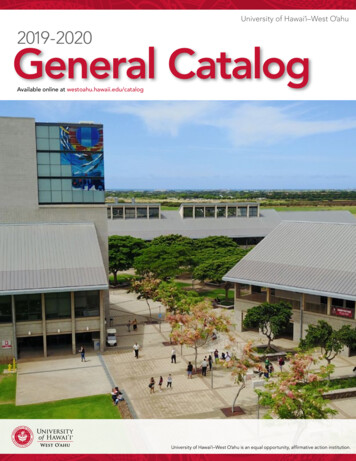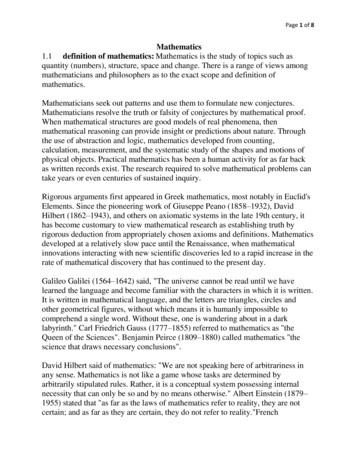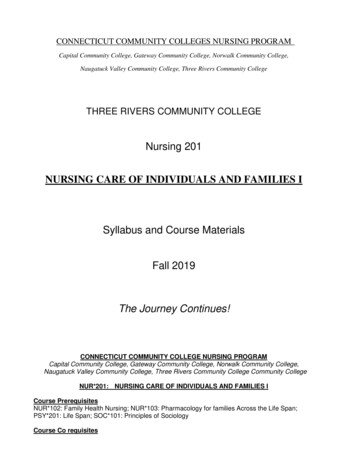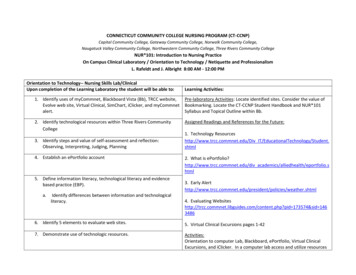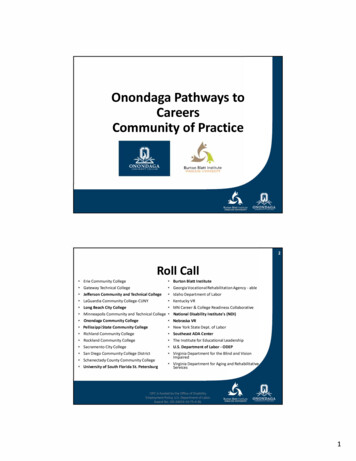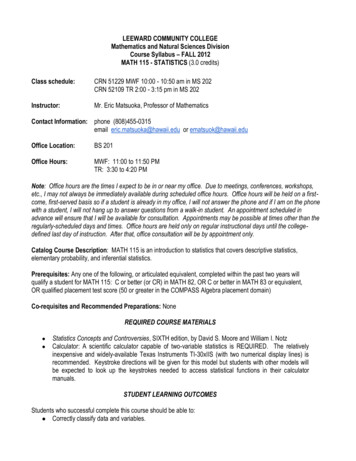
Transcription
LEEWARD COMMUNITY COLLEGEMathematics and Natural Sciences DivisionCourse Syllabus – FALL 2012MATH 115 - STATISTICS (3.0 credits)Class schedule:CRN 51229 MWF 10:00 - 10:50 am in MS 202CRN 52109 TR 2:00 - 3:15 pm in MS 202Instructor:Mr. Eric Matsuoka, Professor of MathematicsContact Information: phone (808)455-0315email eric.matsuoka@hawaii.edu or ematsuok@hawaii.eduOffice Location:BS 201Office Hours:MWF: 11:00 to 11:50 PMTR: 3:30 to 4:20 PMNote: Office hours are the times I expect to be in or near my office. Due to meetings, conferences, workshops,etc., I may not always be immediately available during scheduled office hours. Office hours will be held on a firstcome, first-served basis so if a student is already in my office, I will not answer the phone and if I am on the phonewith a student, I will not hang up to answer questions from a walk-in student. An appointment scheduled inadvance will ensure that I will be available for consultation. Appointments may be possible at times other than theregularly-scheduled days and times. Office hours are held only on regular instructional days until the collegedefined last day of instruction. After that, office consultation will be by appointment only.Catalog Course Description: MATH 115 is an introduction to statistics that covers descriptive statistics,elementary probability, and inferential statistics.Prerequisites: Any one of the following, or articulated equivalent, completed within the past two years willqualify a student for MATH 115: C or better (or CR) in MATH 82, OR C or better in MATH 83 or equivalent,OR qualified placement test score (50 or greater in the COMPASS Algebra placement domain)Co-requisites and Recommended Preparations: NoneREQUIRED COURSE MATERIALS Statistics Concepts and Controversies, SIXTH edition, by David S. Moore and William I. NotzCalculator: A scientific calculator capable of two-variable statistics is REQUIRED. The relativelyinexpensive and widely-available Texas Instruments TI-30xIIS (with two numerical display lines) isrecommended. Keystroke directions will be given for this model but students with other models willbe expected to look up the keystrokes needed to access statistical functions in their calculatormanuals.STUDENT LEARNING OUTCOMESStudents who successful complete this course should be able to: Correctly classify data and variables.
Create and interpret various graphs.Calculate and interpret descriptive statistics, including the mean, median, mode, and standard deviation ofsingle-variable data and the correlation and regression coefficients of paired-variable data. Calculate and interpret probabilities for an event in a probability experiment. Construct and interpret point and interval estimates. Perform and interpret the results of statistical hypothesis tests. COURSE GRADE CALCULATION AND CRITERIAA student’s course letter grade will be assigned by comparing the student’s total accumulated points to thefollowing scale:176.00 or more points earns an A152.00 to 175.99 points earns a B128.00 to 151.99 points earns a C104.00 to 127.99 points earns a DLess than 125.00 points earns an FStudents should note that the minimum points needed for the passing letter grades (A, B, C, and D) are lowerthan the “traditional” 90-80-70-60 percent minimums for the corresponding grades. This course’s cut scoresalready grant the higher letter grade to students who would have “just missed” by the customary standards. Assuch, students who “just miss” a letter grade by these more-generous standards will NOT be given another nudgeup.Project and report: Each student must either work on an individual or a group research projectdirectly to the practice of statistics. Students opting for to perform a group project must assemble a group ofno more than four members by inviting classmates. I will NOT involve myself in the formation of groups.Each individual or group must select a topic, establish a research hypothesis, decide on the division of theworkload (in the case of a group), and submit a written report (including bibliography and self-evaluation). Astudent may author more than one project and/or participate in more than one group but only one projectscore will count toward each student’s course grade. Due dates:1.A list of the group members (or a statement that an individual project will be done)must be submitted by email on or before Sunday, September 16, 2012. Failure tosubmit the required list or statement, or any changes to the group membership afterthis date and not beyond the control of the (remaining) group members will incur ascoring penalty.2.The project’s overall topic must be submitted by email on or before Sunday,September 30, 2012. Changes to the project emphasis or methodology may bemade without penalty; however a substantial change to the overall project topic willincur a scoring penalty.3.Three progress reports that briefly summarizes the progress you or your group hasmade on the project are due by email on the following dates Sunday, October 21, 2012 Sunday, November 11, 2012 Sunday, November 25, 20124.The final report can be submitted either printed on paper or electronically by email orfile drop (www.hawaii.edu/filedrop). Split submissions (some parts by email and
others in printed form) will NOT be accepted except in the case of the self-evaluation(#7 below), which is submitted by individuals rather than on behalf of the group.Printed submissions can be left for me in care of the Math & Sciences Division Office(BS 106a), or in care of the Math Lab (MS 204). The due date is the last scheduledday of instruction for the course:: Wednesday, December 5, 2012 for CRN 51229 (MWF 10:00-10:50 AM) Thursday, December 6, 2012 for CRN 52109 (TR 2:00-3:15 PM)Projects can be submitted any time before the due date but late projects will incur apenalty of 25 percentage points for each calendar day the project is overdue. Project scoring: Each group project can be worth up to 50 points. Every student in a group willreceive the same score for factors #1 through #6 but the self-evaluations (#7) must be written byindividual group members, can be submitted individually, and will be graded individually as well.There is no specified minimum or maximum quantity for the actual submission but students mustkeep in mind the following standards and scoring rubrics:1. Due dates and associated requirements: As a reminder, projects submitted after the duedate above will incur a 25 percentage point penalty for each calendar day the project isoverdue. Were the five Sunday due dates listed above met?i. 1 point for meeting each of the due dates,for a total of 5 possible points.ii. 1 point deduction for any changes to the group membership other than those beyondthe control of the group (such as formal or informal withdrawal of one of the groupmembers)iii. 1 point deduction for a substantive change in the overall project topic.2. Relevance of the project to the course: Did the report evidence the project’s focus onthe theory behind and/or the practice of statistics? Note: When appropriate, intermediatepoints will be awarded for this standard.i. 10 points if the report clearly and directly focuses on the theory behind and/or thepractice of statistics.ii. 5 points if the report’s focus is related to the theory behind and/or the practice ofstatistics but such focus is unclear or indirect.iii. 0 points if the report makes at most tangential references to the practice of statistics.3. Depth of research or insight into the topic chosen: Did the depth of research, asevidenced by the project submission, appear appropriate for a semester-long project?Note: When appropriate, intermediate points will be awarded for this standard.i. 10 points: The report evidences findings and/or insight equivalent to a minimum ofsixteen hours of research and contemplation/interpretation per individual. (note thateighteen hours is the equivalent of one hour per week per person of thought and/oractivity)ii. 5 points: The report evidences findings and/or insight equivalent to eight hours ofresearch and contemplation/interpretation per individual. (note that eight hours isequivelant to half of an hour per week per person of thought and/or activity)iii. 0 points:The report contains little or no evidence of research orcontemplation/interpretation.4. Relationship of the research to the selected project topic: Was the research that wasdone appropriate to the chosen topic? Note: When appropriate, intermediate points willbe awarded for this standard.i. 5 points: The research evidenced by the project submission is clearly and directlyrelated to the selected topic and research hypothesis.
3 points: The research evidenced by the report has some connection to the chosentopic and research hypothesis but some irrelevant distractions obscure thisconnection.iii. 0 points: Distractions dominate the report. The reported research is barely if at allrecognizable as being related to the project topic.5. Clarity, organization, and presentation of the written report: Was the research ingeneral, and the points that supported or contradicted the research hypothesis inparticular, clearly and obviously presented? Note: When appropriate, intermediatepoints will be awarded for this standard.i. 10 points: The report is written in a recognizable format with identifiable sectionsand labeled headers. The research is reported clearly and without substantialdistractors. Any spelling or grammatical errors that may exist are minimal and donot detract from the points made in the report. The font is consistent and largeenough to be readable. Tables and/or graphs were readable and placed in theappropriate sections of the report. Footnotes and endnotes are NOT required but abibliography is included.ii. 0 points: The report contains mostly rambling and pointless discussion, fragmentedand disorganized sections, graphs and tables unrelated to the discussion,distractingly poor printing, and distractingly many spelling errors. Sources wereobviously used but no bibliography is included.6. Consistency of any conclusions drawn: Were the results of the research interpreted in ascientifically and statistically reasonable way? Note: When appropriate, intermediatepoints will be awarded for this standard.i. 5 points: The conclusions that are drawn in the report are consistent with orsupported by the research. Conclusions that are only partially supported by theresearch are identified as such and discussed. Difficulties caused by statistical errorare recognized and discussed.ii. 3 points: The report draws an unambiguous conclusion that was partially supportedbut partially contradicted by the research. Variables other than an independentvariable that might have affected a dependent variable are simply ignored.iii. 0 points: Research results imply at least one conclusion but no attempt is made inthe report to draw a conclusion.iv. 0 points: The report draws conclusions that are wholly contradicted by the research.7. Self-evaluation (5 points): Each member of the group must write their own quantitativeand qualitative assessment of how the submitted project report meets (or fails to meet)each of the above scoring standards (#1 through #6 above). Note: When appropriate,intermediate points will be awarded for this standard.i. 5 points: The self-evaluation is written in complete sentences, includes a thoughtfuland complete analysis and rating of each of the scoring standards that is consistentwith the provided rubrics.ii. 3 points: The self-evaluation is fairly complete and consistent with the report,standards, and rubrics but is not written in complete sentences.iii. 2 points: The self-evaluation is written in complete sentences and is consistent withthe report but addresses only some of the listed standards.iv. 0 points: The self-evaluation is inconsistent with the report.v. 0 points: The self-evaluation ignores the standards completely.ii. Exams: there are three multiple-choice exams that must be taken in the campus test center (belowthe library in the former Learning Resource Center location). Each exam consists of 25 questions
that are worth 2 points each for a total of 50 possible points per exam. Exam content and due datesare: Exam 1 covers part I (chapters 1 to 9) and is due by September 25, 2012 Exam 2 covers part II (chapters 10 to 16) and is due by October 12, 2012 Exam 3 covers parts III and IV (chapters 17 to 24) and is due by December 13, 2012 Exam conditions1. Each exam may be attempted a total of two times by the due date. A student whotakes the exam twice will receive the higher of the two scores for grade calculationpurposes. A student who does not take advantage of a second opportunity toattempt an exam by the due date will forfeit the opportunity and must accept thescore from the first attempt. A student who is unable to take an exam at all by itsdue date must document the circumstances beyond the student’s control in order tobe granted a late attempt. In such cases, only ONE late attempt will be allowed.2. Each exam is taken in the Tests & Quizzes tool of Laulima. Each exam must beproctored in an approved location, is password protected, and has a 90 minute timelimit.3. Each exam allows and requires the use of a scientific or graphing calculator butdoes not permit a smartphone or other device with substantial text storagecapability.4. Each exam is closed-book and closed-notes with the following exception: a student maytake into the testing area ONE sheet of letter-sized paper (up to 8.5 by 11 inches) withnotes on one or both sides of the sheet. Notes may be hand-written or computer printedbut notes printed using tiny font sizes that require magnifying glasses to read will NOT bepermitted. This sheet must be submitted to the testing center upon completion of theexam. Scratch paper, if desired, must be requested from the Testing Center. Due to thisallowance of a “cheat sheet” on each exam, students must submit their cheat sheets andany scratch paper used at the end of the exam and will NOT be provided with the examquestions and answers for studying after the exam is taken.5. Exam problems will either test vocabulary/properties covered in the textbook narrative orbe based on problems that students “should” have worked on and should be familiarwith. In addition, a letter-sized “cheat sheet” represents a generous quantity of notes.Therefore, NO additional details regarding the exam will be provided and NO specificquestions regarding the inclusion or exclusion of particular problem types will beanswered.Bonus Points: There are NO provisions for student-initiated extra credit. An offer will be made inclass but only students who learn of the opportunity in class are eligible. In addition, any terms orconditions attached to the opportunity will be not be subject to change, exception, or negotiation.SOME STUDENT RESPONSIBILITIES Attendance, absence, and participation: Students are expected to attend all class sessions of theclasses for which they are registered. It is the student’s responsibility to contact instructors regarding anyabsence. The acceptance of an excuse for absence is at the discretion of the instructor. Students areexpected to have their textbooks, calculators, and note-taking equipment (writing instrument and paper)during each class session. The powerpoint handouts in the resources section of Laulima are also availablefor printing out and bringing to class to help in note-taking. A student who forgets to bring a calculator shouldgo to the Math Lab (MS-204) to borrow one BEFORE class begins. Beyond being physically present in the
room students are expected to be alert and engaged in the lecture or discussion. Students will beresponsible for all material, discussion, and assignments covered during any missed class session(s).Podcasts covering the textbook material are available in the resources section of Laulima so a student whomisses class should view the podcast that covers the missed chapter(s). Consultation: Students who are having difficulties should see me as soon as possible. Some topicsare prerequisite to later material so ignoring current difficulties will likely result in even more trouble later.Class time: The beginning of each class will be devoted to discussion on recent class topics,assignments, or applications of probability or statistics. Students should pay careful attention since thesediscussions could be used as the basis of the required semester project. Some class sessions will involveindividual and group work in addition to lecture presentations. Studying and homework: Students should carefully read the relevant portion(s) of the textbook andhandouts, and review their class notes BEFORE attempting any assigned homework problems. Someproblems involve only routine computations. Others require reflection, thought, or experimentation on thestudent’s part. I will expect each student to have at least attempted most of the assigned problems beforethe next class meeting. Homework assigned from your textbook will NOT be collected or scored but some ofthese problems are modified for use on your exams. Custody of projects: Semester projects submitted in written form will not be returned to students.STUDENT ASSESSMENT NOTIFICATIONWith the goal of continuing to improve the quality of educational services offered to students, LeewardCC conducts assessments of student achievement of course, program, and institutional learningoutcomes. Student work is used anonymously as the basis of these assessments, and the work you do in thiscourse may be used in these assessment efforts.STUDENT WITH DISABILITIES STATEMENTLeeward Community College abides by Section 504 of the Rehabilitation Act of 1973 and the Americans withDisabilities Act of 1990, which stipulate that no student shall be denied the benefits of an education "solely byreason of a handicap." Students with documented disabilities who believe that they may need accommodationsin this class are encouraged to contact the Coordinator of the KAKO‘O ‘IKE (KI) program as soon as possible toensure that such accommodations are implemented in a timely fashion. The KI office is located in L-208,across from the elevator in the library building or call for information at 455-0421.Leeward Community College’s Maka‘ala ProgramIt is desired that every student be successful at Leeward Community College. Therefore, if the instructor feelsthat you need extra support outside of the classroom in order to have a positive experience in class, theinstructor will refer you to the College’s Maka‘ala Program to ensure that you have access to all of the resourcesyou may need.The Maka‘ala Program is a campus-wide program that seeks to support to students early in the semester whenthey first begin experiencing difficulty in a class. If the instructor feels that you are having difficulty in class withinthe first 5 weeks of the semester, and working together to address your challenges shows that you would reallybenefit from being connected to resources outside of the classroom, the instructor will refer you to the program.Once referred, the Maka‘ala Program will:
Send an email to your hawaii.edu account to let you know about the referral; andHave a counselor follow up with you by phone or by email to find out what kinds of help you might need,to connect you with the necessary resources, and to help you devise a strategy for success.The instructor will not refer you to the Maka‘ala Program without telling you. However, if you are referred to theprogram, know that it has been done in an effort to connect you with all of the help you may need to do well thissemester.Maka’ala means “eyes that are awake,” and reminds us that it is the responsibility of everyone involved—instructors, support services AND students—to be alert, watchful and vigilant and to attend to students’ successwith “wide-open eyes.”Table of podcasts and textbook 202122Chapter 1Chapter 2Chapter 3Chapter 4Chapter 5Chapter 6Chapter 7Chapter 8Chapter r 10Chapter 11Chapter 12Chapter 13193215239261Chapter 14280Chapter 15303Chapter 16327Chapter 17Chapter 18Chapter 19Chapter 20363377393408Chapter 21440Chapter 22Chapter 23Chapter 24463480498Textbookchapters)Exercise numbers1, 3, 5, 7, 9, 11, 13, 151, 3, 5, 7, 9, 11, 13, 15, 171, 3, 5, 7, 9, 11, 13, 15, 17, 19, 21, 23, 25, 271, 3, 5, 7, 9, 11, 13, 15, 17, 19, 291, 3, 5, 7, 9, 11, 13, 15, 17, 19, 211, 3, 5, 7, 9, 11, 15, 191, 5, 7, 9, 11, 13, 17, 21, 231, 3, 5, 7, 9, 11, 15, 17, 19, 21, 231, 3, 5, 7, 9, 11, 13, 15, 17, 19, 21, 231, 3, 5, 7, 9, 11, 13, 15, 17, 19, 21, 23, 251, 3, 5, 7, 9, 11, 13, 15, 171, 3, 5, 7, 9, 11, 13, 15, 17, 19, 21, 23, 271, 2, 3, 5, 7, 9, 11, 13, 15, 17, 19, 21, 23, 25, 271, 3, 5, 7, 9*, 10*, 11, 13, 15, 17, 19, 21, 23*, 25**Use your calculator to find r for the data sets in these problems.1, 3, 5, 7*, 9*, 11*, 13, 15, 17, 18*, 19, 21, 23, 25, 27, 29, 33* (table 15.1 is on p. 305)*Use your calculator to find the equation of the regression line in these problems.1, 3, 5, 7, 9, 11, 13, 17, 19, 23, 25**Browse through the information available on Bureau of Labor Statistics web site tofind the one(s) that give you the current CPI, historical CPI information, andregional and local CPI values.1, 3, 5, 7, 9, 11, 13, 15, 17, 19, 21, 231, 3, 5, 7, 9, 11, 15, 17, 191, 3, 5, 7, 9, 11, 13, 15, 211, 3, 5, 7, 9, 11, 13, 17, 191, 3, 5, 7, 9*, 11, 13, 15, 19, 21, 25, 27*You already have the data; see problem 17.5.1, 3, 5, 7, 9, 11, 13, 15, 17, 21, 23, 27, 29(use the 5% level of significance in each case)1, 3, 5, 7, 9, 11, 13, 151, 3, 5, 7, 9, 11, 13, 15
LEEWARD COMMUNITY COLLEGE Mathematics and Natural Sciences Division Course Syllabus - FALL 2012 MATH 115 - STATISTICS (3.0 credits) Class schedule: CRN 51229 MWF 10:00 - 10:50 am in MS 202 CRN 52109 TR 2:00 - 3:15 pm in MS 202 Instructor: Mr. Eric Matsuoka, Professor of Mathematics Contact Information: phone (808)455-0315

